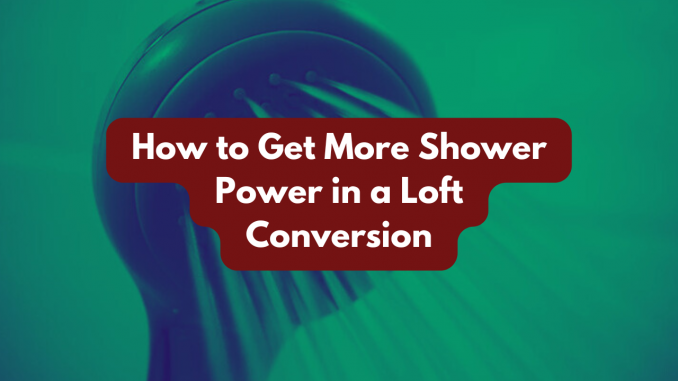
Loft conversions are a fantastic way to maximise space and add value to your home. However, due to their elevated location, ensuring strong water pressure in a loft shower can be a challenge. If you’re struggling with a dribble rather than a deluge, don’t worry—there are practical solutions to boost your shower’s performance. In this guide, we’ll explore the causes of weak shower pressure in loft conversions and what you can do to achieve that all-important “shower power.”
What Gives Shower Power?
Before diving into solutions, it’s worth understanding what contributes to strong water pressure in the first place. The key factors include:
Water Pressure from Your Mains Supply
Your home’s water pressure is dictated by the mains supply. If your mains pressure is inherently low, it will affect the performance of all taps and showers in your house, including those in the loft.
Gravity and Water Tanks
In many UK homes, water systems rely on gravity to create pressure. The higher the cold-water storage tank is above your shower, the better the pressure. In a loft conversion, this distance is often minimal, leading to weaker water flow.
Shower Type
Different types of showers are better suited to varying water pressures. For instance, a power shower with an integrated pump can enhance water flow, while an electric shower heats water independently but relies on mains pressure.
Pipework
The design and condition of your plumbing system can also impact pressure. Narrow or ageing pipes can restrict water flow, reducing the overall pressure reaching your shower.
Common Issues with Loft Showers
Installing a shower in a loft conversion can reveal several pressure-related issues. Here are the most common problems homeowners face:
Low Head Height
In traditional gravity-fed systems, the height of the cold-water storage tank relative to the shower head is crucial. If your tank is situated just above or level with your loft, there won’t be enough gravitational force to create decent pressure. This can be difficult to the ceiling height of your loft.
Inadequate Mains Pressure
Some properties, especially older ones, have mains pressure that falls below the recommended 1 bar. This can impact all fixtures, but the loft shower will feel it the most.
Long or Narrow Pipes
The further water has to travel and the narrower the pipes, the more friction it encounters. This can slow the flow to your shower.
Pump-Free Systems
Without a pump, gravity-fed systems struggle to deliver sufficient pressure to loft showers. Additionally, modern mixer showers and rainfall-style heads often require higher pressure to function optimally.
How to Boost Shower Power in a Loft Conversion
Fortunately, there are several ways to improve water pressure in a loft shower. Here are some practical and effective solutions:
Install a Shower Pump
A shower pump is a fantastic option for homes with gravity-fed systems. It boosts water flow and pressure, transforming a weak trickle into a satisfying stream. Pumps are available in different power ratings, so consult a plumber to choose the right one for your needs.
Switch to a Pressurised Unvented System
Consider upgrading your home’s plumbing system to an unvented cylinder. These systems operate directly off mains pressure, eliminating the need for gravity and ensuring strong flow to all fixtures, including the loft shower.
Opt for an Electric Shower
Electric showers heat water independently and work directly off the mains supply. While they don’t increase pressure, they are a reliable option if your mains pressure meets the minimum requirement.
Fit a Boosting System
Mains pressure boosting systems can be installed to improve overall water pressure in your home. These systems are particularly useful if your mains pressure falls below 1 bar.
Reconfigure Pipework
Upgrading to wider pipes or reducing the distance water has to travel can minimise friction and improve flow. Discuss pipework design with your plumber to optimise efficiency.
Relocate the Cold-Water Tank
If you have the space, raising the cold-water storage tank higher in the loft can increase gravitational pressure. However, this may not always be feasible due to space constraints.
Maintenance Tips for Consistent Shower Power
Once you’ve addressed the fundamental issues, maintaining your system is key to ensuring long-term performance. Here are some tips:
- Descale Shower Heads Regularly: Limescale build-up can restrict water flow. Soak your shower head in a descaling solution to keep it clean.
- Check for Leaks: Leaky pipes or fittings can reduce pressure. Inspect your system regularly and address any issues promptly.
- Service Pumps and Systems: If you’ve installed a pump or boosting system, ensure it’s serviced regularly to keep it running efficiently.
- Monitor Mains Pressure: Keep an eye on your mains water pressure. If it drops unexpectedly, contact your water supplier for assistance.
Getting more shower power in a loft conversion may seem like a daunting challenge, but with the right approach, you can transform your morning routine. From installing a shower pump to upgrading your plumbing system, there are solutions to suit every home and budget. By understanding the causes of weak pressure and addressing them effectively, you can enjoy a powerful, invigorating shower—no matter how high up in your house it is.

Leave a Reply